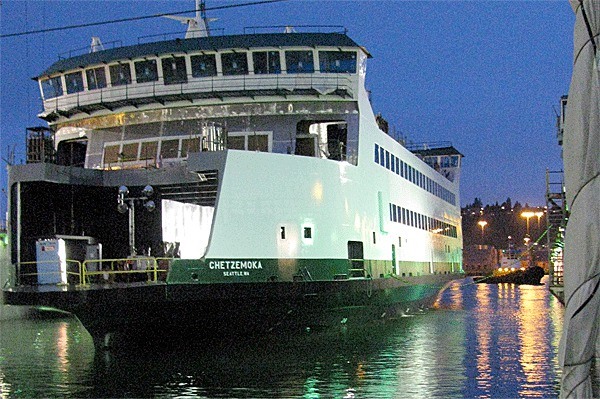On the heels of a performance problem that has pushed back the Chetzemoka’s arrival by about six weeks, Washington State Ferries officials have now confirmed that the boat has a list.
According to Capt. George Capacci, deputy chief of operations and construction, it is not a design flaw nor will it further delay the vessel’s arrival. In fact the list was expected as it is present in the Island Home, the ferry operating out of Chesapeake Bay that the Chetzemoka is designed after.
A list — a condition that causes the vessel to lean to one side in the water — can result from a variety of factors, ranging from leaks to unbalanced cargo or vessel construction. In this case, the Chetzemoka is leaning to one side primarily because the vessel’s stairwells are located on one side of the ship and not in the center as is the case with most state ferries.
“It’s a design tradeoff; it maximizes deck space,” Capacci said.
Capacci said that while most ferries have their stairwells in the center of the vessel, or have one on each side to evenly distribute the weight, nearly all state ferries have a list to some degree.
However, this may be the first time one of the boats has earned a nickname for the condition. Ferry workers are unofficially dubbing the boat the “I-Lean.” While it’s not the nickname he envisioned for the brand new $76.5 million vessel, Capacci said it was not all that bad.
“There’s a lot worse names out there,” he said.
The 64-car ferry was built by Seattle-based Todd Pacific Shipyards. Company CEO Stephen Welch did not respond to requests for comment Monday and Tuesday.
The Chetzemoka is the first of three new ferries being built for the state. It was scheduled to relieve the borrowed Pierce County ferry, the Steilacoom II, and begin service on the Keystone-Port Townsend ferry route Aug. 30. The arrival was delayed, along with community celebrations planned on both sides of the run, when vibrations were discovered in the vessel’s driveline.
The problem was the result of cavitation, the creation of a pocket of air around a spinning propeller. In an Aug. 19 press release, ferries officials stated the problem was solved with computer software that would regulate engine speed. It indicated that the state would take possession of the vessel sometime this week and begin about six weeks of crew training.
“We believe we have resolved the issue of vibrations, and we’ll be looking to confirm that as the Chetzemoka is put through all kinds of maneuvers and situations by our crews,” said David Moseley, assistant secretary for Washington State Ferries, in the press release. “We are excited to put this wonderful new ferry into service in the Pacific Northwest.”
But while the listing issue is not expected to affect the vessel’s performance — Capacci said that it is not a design flaw — the Chetzemoka may have other problems as well. Capacci confirmed that the new ferry’s rub-rails are too small and that a window was cracked recently while the boat was tied up when it bumped up against the dock.
“That’s something that we need to look at an address,” he said.
The vessel also lacks walk-railings along its windows on the outside of the vessel. Those railings are common on ferries, and important, as they are used by workers to walk on when cleaning the windows. Capacci said he didn’t know how the rub-rail issue will be tackled, but offered that ferry workers might be able clean the outside windows using “long poles.”
Small problems such as these will be addressed when crew training begins this week. Those that can’t be solved immediately will investigated further, he said.



